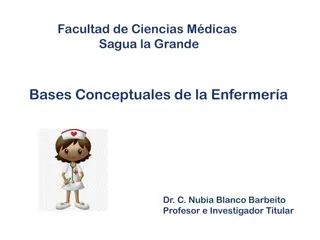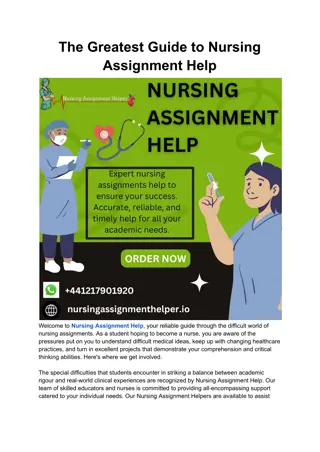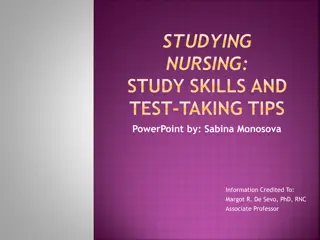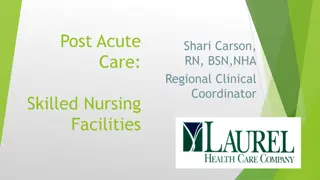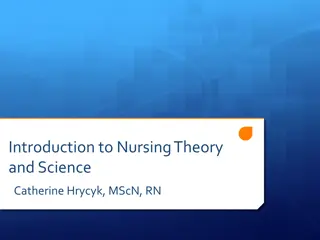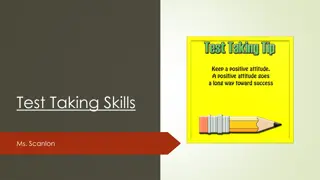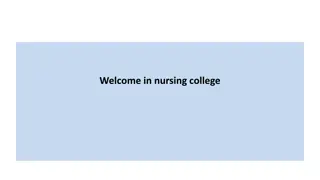Mastering Nursing Test-Taking Skills
Explore the essential elements of test-taking skills in nursing, from analyzing questions to using strategies for choosing the right answers. Learn how to identify critical elements, eliminate incorrect options, and interpret test questions effectively. Enhance your test-taking techniques by understanding the components of test questions and practicing with examples. Improve your ability to select the correct answers by mastering the introductory statements, stems, and options in nursing tests.
Download Presentation

Please find below an Image/Link to download the presentation.
The content on the website is provided AS IS for your information and personal use only. It may not be sold, licensed, or shared on other websites without obtaining consent from the author.If you encounter any issues during the download, it is possible that the publisher has removed the file from their server.
You are allowed to download the files provided on this website for personal or commercial use, subject to the condition that they are used lawfully. All files are the property of their respective owners.
The content on the website is provided AS IS for your information and personal use only. It may not be sold, licensed, or shared on other websites without obtaining consent from the author.
E N D
Presentation Transcript
Objectives Discuss the critical elements of test taking skills Demonstrate how to analyze nursing questions Practice test taking skills (TTS) Evaluate the TTS process 2
In order to choose the right answer; you must Understand the question - Identify the critical elements Eliminate the incorrect options - This is a critical step Use your test taking strategies Identify the global response or more comprehensive answer Eliminate similar distractors: saying the same thing or about the same thing Look for similar words that are included in the scenario or stem - - - 3
Three Test-taking Techniques 1. Analyze Test Questions What is the stem of the question asking? 2. Interpret Test Questions Know the things to look for in each question 3. Use techniques to eliminate incorrect answers Choose the right answer. 4
Three parts of a Test Questions 1. Introductory Statement Gives you information about the problem 2. Stem Ask you to select the correct answer 3. Four Options Includes only one correct answer (usually) 5
Introductory Statement Introductory Statement sets up the scenario. The Stem ask the nurse to solve a specific problem. will include: Information about the clinical problem Clinical data nursing topic Intervention or disease 6
Examples During dinner, a client puts on his call light. When the nurse enters his room, she notices that he cannot talk and is grasping his throat with his hands. (Introduction) What is the first nursing action in this situation? (Stem) What concept you are being tested on? When the nurse is making morning rounds, one of her clients says to her, I almost died last night. (introduction) The most therapeutic nursing response is: (Stem) What concept are you being tested on? 7
Examples: Compare the two questions A client had a stroke two weeks ago. He is paralyzed on the left side. While getting him out of bed to sit in a wheelchair, which nursing action is essential? What concept are you being tested on? A client had a stroke two weeks ago. He is paralyzed on the left side. In transferring him to a wheelchair, the nurse notices a reddened area on his left hip. Which nursing action is essential? What concept are you being tested on? 8
It is Important to Identify what the question is telling you and asking you. Remember that incorrect options may answer something that is not being asked. Remember that incorrect options may include information not in the case scenario Read each question carefully. This will help you make the most of your nursing knowledge when taking the exam. 9
The Four Critical Elements: #1- The Key word What is the Key Word in the question? Key words are important words or phrases in a question Key words focus your attention on crucial ideas in the stem and in the options Key words may include words such as: Early or late Immediately, priority, or postoperatively Initially or most likely or least likely On admission, most therapeutic 10
Four Critical Elements: #2 The Client Who is the client in the Question? The client is the person who is the focus of the question (Drug in Pharmacology) May be the person with the health problem, but that is not always true The client may be: The family The institution The member of the health care team The patient Another person on the unit. 11
Four Critical Elements: #3 The Issue What is the Issue (or topic) in the Question? The issue is the specific problem or subject that the question is asking about. The issue could be: A drug A problem A toxic effect A behavior A disorder A procedure 12
Four Critical Elements: #4 The Stem Type What is the Stem type? The stem is the part of the question that ask you to solve the problem To select the correct response you need to determine the stem type Positive stem Appropriate question Negative Stem Inappropriate question 13
True Response: Positive True response stems are questions for which answer must be an appropriate nursing action Example: An appropriate nursing action would be The most essential nursing action The highest priority nursing action A safe nursing judgment A therapeutic response An accurate rationale for nursing action The correct explanation 14
Examples of a True/Positive Response Which nursing action is most important The nurse understands the chief purpose of the The nurse would demonstrate the bestaction Which comment by the nurse demonstrates the best understanding Which response is the most therapeutic The nurse should give immediate consideration Initially, the nurse should 15
False Response: Negative The false response stems indicate the best option will be the one which is an inappropriate nursing action. May be the option which is unimportant or otherwise negative Examples: The least important concern for the nurse Which nursing action is unsafe Which would the nurse identify as least likely Which medication is contraindicated The nurse would do all except . 16
The Four Options Eliminate the incorrect options based on the type of stem Most test have three distracters and one correct answer First, decide if the question is Positive or Negative Then read the options and determine if the option is appropriate or inappropriate Positive stems have appropriate answers Negative stems have inappropriate answers 17
Misreading Test Questions Misreading test questions happen because you; incorrectly analyze what the question is asking overlook important words in the stem and in the introduction scenario read into the question incorrectly determine the disorder 18
Tips To Avoid Misreading Separate the case scenario and stem Identify the client, issue, and stem type Pay attention to important Key words like: Priority Restate the question in your own words Eliminate options that give new information or requires you to make assumptions about the client Don t misinterpret the disorder: know your material 19
Narrowing you options Make a decision about each option as you read it Once you eliminate an option, do not go back and change it!! If you are left with one option you know and one you do not, chose the one you know. Eliminate options that include terminal words like; always and never Read all options before making a selection 20
Summary As you answer the questions remember to ask yourself What are the key words? Who is the client ? What is the issue? Is this a positive or negative question? Restate the question in your words. 21
Select All That Apply https://www.youtube.com/watch?v=P4zgGCLdDSM&nor edirect=1 By ATI Testing Company You must understand the topic of the question before you can answer the question. Read the stem carefully and thoroughly before looking at the options. Read the all the options and eliminate as many as you can. Don t panic- they are only True/False questions. 22
Practice Questions #1 While caring for a client with an IV, it is most important for the nurse to; A. Report any signs of infection to the charge nurse B. Record the condition of the IV site and the rate of infusion, and report any unusual findings C. Record IV intake D. Ask the client if the IV site is painful or tender 23
Practice Questions #2 A nurse is preparing to give a morning medication. The first nursing action in the activity is to; A. Read the label B. Check for the right dose C. Wash the nurse s hands. D. Check for the right time. 24
Practice Question #3 A trauma client, admitted through the emergency room, has a urinary catheter inserted to monitor kidney function and assess for early signs of shock. The nurse would report which urinary output measurement as suggestive of cardiac failure or hypovolemia? A. 20 ml/hr B. 35 ml/hr C. 40 ml/hr D. 50 ml/hr 25
Practice Question #4 Mr. Smith and Mr. Rodriques are sitting in the day lounge. The nurse has a medication to administer to Mr. Smith When the nurse enters the lounge, Mr. Rodriques says to the nurse, I see you found me to give me my pills? The best nursing response would be; A. I don t have any pills for you Mr. Smith. B. Let me check your identification arm band, and I will check to see if you are suppose to receive any pills . C. Mr. Smith, I have pills for you to take, but none for Mr. Rodriques . D. Mr. Smith would you please take these pills . 26
Practice Question #5 A 72 year-old client was admitted to the hospital with pneumonia. He is receiving oxygen at 4 liters per mask. In obtaining his vital sign, which nursing action is inappropriate. A. Taking an Axillary temperature B. Listening to his lungs when counting respirations C. Listening to an apical heart rate D. Taking an oral temperature 27
Practice Question #6 When inserting a nasogastric tube in a comatose client for internal tube feeding, it is inappropriate for the nurse to; A. Measure the amount of the tube to be inserted. B. Lubricate the distal portion of the tube. C. Tilt the client s head back when inserting the tube. D. check for placement of the tube. 28
Practice Question #7 The best nursing action to prevent the spread of infection among hospitalized clients is; A. Using sterile technique when performing any procedure. B. Hand washing before coming in contact with each client C.. Wearing gloves to perform procedures. D. Wearing mask and gown while performing procedures. 29
Practice Question #8 A client is ambulating down the tile hallway in her stocking-covered feet. How should the nurse ensure the client s safety? A. Remind the client to avoid any wet spots on the floor. B. Tell the client that she should always wear slippers when ambulating. C. Get the client s slippers and have her put them on. D. No action is necessary, since the client has her feet covered. 30
Practice Question #9 A visitor asks the nurse about the client in the next room who cries frequently; What is the matter with him? The most appropriate response by the nurse is; A. Mr. Tang has cancer and is very uncomfortable. B. Mr. Tang is kept as comfortable as possible. C. Mr. Tang is quite uncomfortable. Does the crying bother you? D. I cannot reveal anything about the patients diagnosis. 31
Practice Question #10 A client with osteoarthritis complains of discomfort when performing exercises prescribed by the physical therapist. Which response by the nurse is most appropriate? A. The exercise will prevent pain. B. The exercise will prevent worsening of the disease. C. The exercise will help to maintain as normal joint function as possible and range of motion. D. The exercise will make you feel better. 32
Practice Question # 11 The most common, preventable complication of abdominal surgery is; A. atelectasis. B. fluid and electrolyte imbalance. C. thrombophlebitis. D. urinary retention. 33
Practice Question # 12 A medical-surgical nurse, who is caring for a patient with a new diagnosis of cancer, observes the patient becoming angry with the physicians and nursing staff. The best approach to diffuse the emotionally charged discussion is to: A. Allow the patient and family members time to be alone. B. Arrange time for the patient to speak with another patient with cancer. C. Direct the discussion and validation of emotion, without false reassurance. D. Request a consult from a social worker on the oncology unit. 34
Practice Question # 13 The nursing diagnosis for a patient with a myocardial infarction is Activity Intolerance. The plan of care includes the patient outcome criteria of; A. agreeing to discontinue smoking. B. ambulating 50 feet without experiencing dyspnea. C. experiencing no dyspnea on exertion. D. tolerating activity well. 35
Practice Question #14 A patient is admitted to the same day surgery unit for liver biopsy. Which of the following laboratory tests assesses coagulation? Select all that apply. A. Partial thromboplastin time. B. Prothrombin time. C. Platelet count. D. Hemoglobin E. Complete Blood Count F. White Blood Cell Count 36
Practice Question #15 The nurse is teaching the client how to use a metered dose inhaler (MDI) to administer a Corticosteroid drug. Which of the following client actions indicates that he is using the MDI correctly? Select all that apply. A. The inhaler is held upright. B. Head is tilted down while inhaling the medication C. Client waits 5 minutes between puffs. D. Mouth is rinsed with water following administration E. Client lies supine for 15 minutes following administration. 37
Answers 1. B 9. D 2. C 10. C 3. A 11. A. 4. B 12. C 5. D 13. B 6. C 14. A, B 7. B 15. A, D 8. C 38




